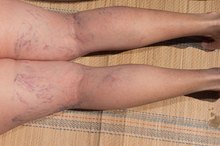What does fact checked mean?
At Healthfully, we strive to deliver objective content that is accurate and up-to-date. Our team periodically reviews articles in order to ensure content quality. The sources cited below consist of evidence from peer-reviewed journals, prominent medical organizations, academic associations, and government data.
The information contained on this site is for informational purposes only, and should not be used as a substitute for the advice of a professional health care provider. Please check with the appropriate physician regarding health questions and concerns. Although we strive to deliver accurate and up-to-date information, no guarantee to that effect is made.
Blood Clot After Surgery Symptoms
Blood clots are not uncommon after surgery, especially major surgery on the pelvis, knees or hip. Blood clots, known as deep vein thrombosis (DVT), form most often in the lower leg or thigh, the Merck Manual states, but can also develop in the upper extremities 1. Immobility after surgery leads to a decrease in blood return from the veins to the heart, since activity normally helps move blood back to the heart. Blood pools in the legs, facilitating development of blood clots. In 50 percent of cases, DVT has no symptoms, Massachusetts General Hospital (MGH) states.
If you are experiencing serious medical symptoms, seek emergency treatment immediately.
Pain and Tenderness
In many cases, DVT causes pain in the affected extremity. Pain may be more intense when standing or walking if the DVT is in the leg. Touching the extremity may cause discomfort. Sometimes the discomfort is mild in lower extremity DVTs, more like a dull ache, which may be felt only when walking, MGH explains.
- In many cases, DVT causes pain in the affected extremity.
- Sometimes the discomfort is mild in lower extremity DVTs, more like a dull ache, which may be felt only when walking, MGH explains.
Visual Symptoms
Complications of Endovenous Laser Treatment
Learn More
DVTs can cause noticeable visual changes in the extremity. These include redness, warmth, swelling and discoloration in the area of the DVT. The vein may appear ropy and lumpy, and the veins around the affected vein may appear dilated and more visible than usual. When the skin over the affected area is pressed, a small dimple, known as pitting edema, may remain. The Merck Manual states that a difference of 3cm in circumference between the affected and non-affected leg due to swelling is most likely to indicate a DVT.
- DVTs can cause noticeable visual changes in the extremity.
- The vein may appear ropy and lumpy, and the veins around the affected vein may appear dilated and more visible than usual.
Respiratory Symptoms
The most serious symptom of DVT occurs when a large clot breaks away from the extremity and travels to the lungs. A pulmonary embolism, or PE, occurs when a clot lodges in the arteries of the lungs, causing decreased blood flow 3. Around 50 percent of people with DVTs have occult, or asymptomatic PEs, Merck reports; large PEs can be life-threatening if they block the flow of blood from the right side of the heart to the lungs. Symptoms include:
- sudden shortness of breath
- wheezing
- coughing
- chest pain
- rapid
- weak or irregular heartbeat
- light-headedness or fainting
- low blood pressure
Baylor College of Medicine reports that 4 out of 100 people who develop DVT die from PE complications.
- The most serious symptom of DVT occurs when a large clot breaks away from the extremity and travels to the lungs.
- Around 50 percent of people with DVTs have occult, or asymptomatic PEs, Merck reports; large PEs can be life-threatening if they block the flow of blood from the right side of the heart to the lungs.
Long-Term Damage
DVT Symptoms in the Legs
Learn More
A DVT can permanently damage the veins in a leg or an arm. Long-term damage can cause permanent swelling of the extremity and skin breakdown over the damaged area. Discoloration, scaling and itching can occur, and the extremity may be painful during use.
Related Articles
References
- Medline Plus: Deep Vein Thrombosis
- Massachussettts General Hospital: Deep Vein Thrombosis
- Mayo Clinic: Pulmonary Embolism
- The National Heart, Lung and Blood Institute. Deep Vein Thrombosis.
- Lee JS, Moon T, Kim TH, et al. Deep Vein Thrombosis in Patients with Pulmonary Embolism: Prevalance, Clinical Significance and Outcome. Vasc Specialist Int. 2016;32(4):166–174. doi:10.5758/vsi.2016.32.4.166
- U.S. Centers for Disease Control and Prevention. Data and Statistics on Venous Thromboembolism. Last reviewed February 7. 2020.
- Cosmi B. Management of superficial vein thrombosis. J Thromb Haemost. 2015;13(7):1175-83.
- Kesieme E, Kesieme C, Jebbin N, Irekpita E, Dongo A. Deep vein thrombosis: a clinical review. J Blood Med. 2011;2:59–69. doi:10.2147/JBM.S19009
- Suadicani P, Hannerz H, Bach E, Gyntelberg F. Jobs encompassing prolonged sitting in cramped positions and risk of venous thromboembolism: cohort study. JRSM Short Rep. 2012;3(2):8. doi:10.1258/shorts.2011.011121
- Kapoor CS, Mehta AK, Patel K, Golwala PP. Prevalence of deep vein thrombosis in patients with lower limb trauma. J Clin Orthop Trauma. 2016;7(Suppl 2):220–224. doi:10.1016/j.jcot.2016.07.003
- Vinogradova Y, Coupland C, Hippisley-Cox J. Use of hormone replacement therapy and risk of venous thromboembolism: nested case-control studies using the QResearch and CPRD databases. BMJ. 2019 Jan 9;364:k4810. doi: 10.1136/bmj.k4810.
- Stone J, Hangge P, Albadawi H, et al. Deep vein thrombosis: pathogenesis, diagnosis, and medical management. Cardiovasc Diagn Ther. 2017;7(Suppl 3):S276–S284. doi:10.21037/cdt.2017.09.01
- Baker M, dela Cruz J. Deep Venous Thrombosis Ultrasound Evaluation. [Updated 2019 May 10]. In: StatPearls [Internet]. Treasure Island (FL): StatPearls Publishing; 2019 Jan-. Available from: https://www.ncbi.nlm.nih.gov/books/NBK470453/
- Mayo Clinic. Deep Vein Thrombosis (DVT). Last reviewed March 6, 2018.
- Ortel TL, Neumann I, Ageno W, et al. American Society of Hematology 2020 guidelines for management of venous thromboembolism: treatment of deep vein thrombosis and pulmonary embolism. Blood Adv. 2020 Oct 13;4(19):4693-4738. doi: 10.1182/bloodadvances.2020001830.
- Clarke MJ, Broderick C, Hopewell S, Juszczak E, Eisinga A. Compression stockings for preventing deep vein thrombosis in airline passengers. Cochrane Database Syst Rev. 2016;9:CD004002.
- Piparva KG, Buch JG. Deep vein thrombosis in a woman taking oral combined contraceptive pills. J Pharmacol Pharmacother. 2011;2(3):185–186. doi:10.4103/0976-500X.83284
- Centers for Disease Control and Prevention. Venous Thomboembolism (Blood Clot) Data & Statistics. February 2018
- Centers for Disease Control and Prevention. Basics of Venous Thromboembolism. April 2018.
- The American Society of Hematology. Blood Clots.
- The National Heart, Lung and Blood Institute. Deep Vein Thrombosis.
Writer Bio
A registered nurse with more than 25 years of experience in oncology, labor/delivery, neonatal intensive care, infertility and ophthalmology, Sharon Perkins has also coauthored and edited numerous health books for the Wiley "Dummies" series. Perkins also has extensive experience working in home health with medically fragile pediatric patients.








